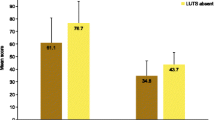Abstract
Our objective was to determine the extent to which lower urinary tract symptoms affect the general health status of men and contribute to the decision to undergo surgery. A cross-sectional population survey using postal questionnaires was conducted in the North West Thames health region, followed by a prospective cohort study of men undergoing prostatectomy (North West Thames and Oxford regions). The subjects in the first survey were 221 men aged 55 and over with previously reported mild, moderate or severe urinary symptoms; subjects in the second study were 388 men undergoing prostatectomy. Main outcome measures were selfreported symptom severity, bothersomeness and general health status (Nottingham Health Profilie, Part 1). The response rate among eligible responders in the population survey was 85.7%. Increasing symptom severity was associated with worsening NHP scores for energy, emotional reactions, sleep and physical mobility (p<0.01). Increasing bother-someness of symptoms was associated with emotional reactions, sleep and pain (p<0.05). Men undergoing surgery reported worse health status than men in the population with the same severity of symptoms as regards emotional reactions, energy and pain. For a given level of symptom severity, the impact of those symptoms on aspects of a man's general health status may be the determinant of seeking and undergoing surgery. Greater understanding of the factors that affect a man's response to his symptoms is needed in interpreting the decision to seek and accept treatment.
Similar content being viewed by others
References
Hunter DJW, McKee CM, Black NA, Sanderson CFB. Urinary symptoms: Prevalence and severity in British men aged 55 and over.J Epidemiol Comm Health 1994;48: 569–575.
Garraway WM, Collins GN, Lee RJ. High prevalence of benign prostatic hypertrophy in the community.Lancet 1991;338: 469–471.
Garraway WM, Russell EBAW, Lee RJ, et al.. Impact of previously unrecognized benign prostatic hypertrophy on the daily activities of middle-aged and elderly men.Brit J Gen Pract 1993;43: 318–321.
Tsang KK, Garraway WM. Impact of benign prostatic hyperplasia on general well-being of men.Prostate 1993;23: 1–7.
Guess HA, Chute CG, Garraway WM, et al.. Similar levels of urological symptoms have similar impact on Scottish and American men—although Scots report less symptoms.J Urology 1993;150: 1701–1705.
The Department of Veterans Affairs Cooperative study of transurethral resection of the prostate. A comparison of quality of life with patient reported symptoms and objective findings of men with benign prostatic hyperplasia.J Urol 1993;150: 1696–1700.
Hunt S and McKenna SP.The Nottingham Health Profile User's Manual. Manchester: Galen Research & Consultancy, 1991.
Hunter DJW, McKee CM, Black NA, Sanderson CFB. The health status of British men with urinary symptoms: results of the SF-36.Urology 1995;45: 962–971.
Doll HA, Black NA, Flood AB, McPherson KM. Patient-perceived health status before and up to 12 months after TURP for benign prostatic hypertrophy.Br J Urol 1993;71: 297–305.
Doll HA, Black NA, Flood AB, McPheron KM. Criterion validation of the Nottingham profile: Patient views of surgery for benign prostatic hypertrophy.Soc Sci Med 1993;37: 115–122.
Hunter DJW, McKee CM, Black NA, Sanderson CFB. Health care sought and received by men with urinary symptoms, and their views on prostatectomy.Brit J Gen Pract 1995;45: 27–30.
Barry MJ, Fowler FJ, O'Leary MP, et al. The American Urological Association's symptom index for benign prostatic hyperplasia.J Urol 1992;158: 1549–1575.
Black NA, Petticrew M, Mcpherson K. Comparison of NHS and private patients undergoing elective transurethral resection of the prostate for benign prostatic hypertrophy.Qual Health Care 1993;2: 11–16.
Author information
Authors and Affiliations
Rights and permissions
About this article
Cite this article
Hunter, D.J.W., McKee, C.M., Black, N.A. et al. The impact of lower urinary tract symptoms on general health status and on the use of prostatectomy. Qual Life Res 4, 335–341 (1995). https://doi.org/10.1007/BF01593886
Issue Date:
DOI: https://doi.org/10.1007/BF01593886



